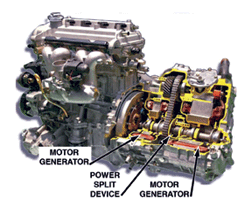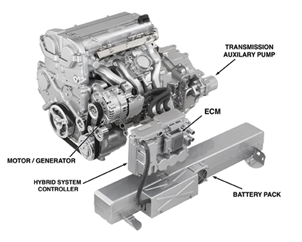A long time ago in a service bay, preventive maintenance for an automatic transmission was an oil change, band and throttle linkage adjustment. The 1960s saw the end of external band adjustments. In the 1970s, the drain plug went away and the pick up screen was replaced with a filter. In the 1980s, a turbo hydramatic would get a 25,000-mile fluid and filter change. The throttle linkage was replaced with a vacuum modulator. The 1990s saw the end of mechanical control which was replaced by the computer-controlled force motor and shift solenoids.
 The dipstick is being eliminated on most of the new and current transmissions and the 50,000-mile fluid and filter change is only recommended for vehicles that are operated under extreme conditions, such as trailer towing and commercial service. Fifty years later, there is no recommended preventive maintenance.
The dipstick is being eliminated on most of the new and current transmissions and the 50,000-mile fluid and filter change is only recommended for vehicles that are operated under extreme conditions, such as trailer towing and commercial service. Fifty years later, there is no recommended preventive maintenance.
The following is from a 2005 GM owner’s manual and Goodwrench service recommendations:
“It is not necessary to check the transmission level. A transmission fluid leak is the only reason for fluid loss. If a leak occurs, take your vehicle to the dealership service department and have it repaired as soon as possible. You may also have your fluid level checked by your dealer or service center when you have your oil changed.”
New automatic transmissions are sealed systems with limited fluid service access. This is through a fill plug or vent. Some transmissions have a combination vent and fill plug. A fill plug is usually located on the main case or side cover depending on the manufacturer. Follow the vehicle’s service information for the correct procedure to check the fluid level.
Heat is the major cause of degradation. If the vehicle is located where ambient temperatures exceed 90º F (32º C) or higher for a significant part of the year, or extreme driving conditions such as trailer towing, most manufacturers recommend a 50,000-mile oil and filter change. As fluid degrades, it can affect the operation of the clutches, valve body and solenoids.
Oil degradation affects clutch packs more that any other component in the transmission. During early 2005, General Motors released a newly developed fluid for the factory fill of all GM powertrain stepped planetary gear automatic transmissions. The fluid provides significantly improved performance in terms of clutch friction material durability.
There are improvements in viscosity, aeration control and oxidation resistance. In addition, the fluid has extended drain intervals. Since the performance of new fluid exceeded that of the DEXRON-III, it became necessary to upgrade the specification. The upgrade for the factory and service is designated DEXRON-VI. The product is available from all major oil companies serving the aftermarket.
High temperature operation and water can accelerate the oxidation of the fluid. Passenger and light truck Automatic Transmission Fluid (ATF) has a life expectancy of approximately 150,000 miles with the transmission operating at 195º F (91º C). This is the same operating temperature as the engine coolant. Adding the wrong type of fluid or water entering through the dipstick, fill plug or vent can contaminate the oil. This can cause the fluid to change color.
 Water in the oil reduces lubricity and degrades additives. Water can enter the transmission as condensation through the vent. As the transmission warms and cools, water vapor in the air is drawn into the transmission and the water will condense into a liquid. The amount of water drawn into the transmission is very small, but can accumulate over a long period. The number of times the transmission is cycled will also affect the amount of water accumulated.
Water in the oil reduces lubricity and degrades additives. Water can enter the transmission as condensation through the vent. As the transmission warms and cools, water vapor in the air is drawn into the transmission and the water will condense into a liquid. The amount of water drawn into the transmission is very small, but can accumulate over a long period. The number of times the transmission is cycled will also affect the amount of water accumulated.
In addition to reducing the oil’s lubricating quality, high temperature produces a varnish on internal parts. Above 250º F seals can develop leakage that reduces applied pressure to clutch packs resulting in slippage. ATF manufacturers suggest that for every 20º F (7º C) increase in operating temperature above the normal 195º F (91º C) the life of the fluid is cut in half.
There is no set time limit as to when the fluid should be changed, but it would seem logical to treat the transmission the same as the cooling system.
The cooler is a critical component to the operating life of the transmission. It can be mounted in the radiator outlet tank or as an air-cooled external type. The passages in these coolers are extremely small and any restriction of the passages will reduce the efficiency of the cooler. A burnt clutch pack can be a source of cooler contamination. Clutch packs are made up of steel drive plates and driven plates that have friction material on both sides. Contamination can also accumulate in the valve body and solenoid valves. The filter may not be able to contain all of the contamination. Vehicles that are frequently towing a trailer should consider an auxiliary cooler. The transition from the purely mechanical shift control to computer-controlled throttle position force motors and shift solenoid valves have allowed engineers to match engine performance to transmission operation. The powertrain control module (PCM) or transmission control module (TCM) operate all of the shift functions. The controllers can match engine and transmission by sharing engine inputs such as RPM, throttle position and transmission inputs for gear selection and transmission input shaft speed for engine load. The scan tool can provide information for the diagnosis of a transmission problem.
The PCM or TCM can provide a method of testing components simply by using the functions. The key is having current service information to support your scan tool as each manufacturer has a specific approach to diagnostics and repair.
The hybrid electric vehicle (HEV) transmissions present a different prospective on transmission operation. There are two types of hybrid propulsion systems. The Toyota system uses a planetary gear set and computer control of its electric motors and internal combustion engine (ICE) and the parallel-type used by Ford, GM and Honda that provides both ICE and motor power at the same time. The ICE is not in continuous operation during all hybrid modes for both systems. If the gasoline engine operates the automatic transmission pump, there must be an additional pump powered by an electric motor to supply hydraulic pressure to apply the clutches. This is the system used by GM Saturn hybrid system.
The Toyota system uses two motor/generators and an ICE. A power coupling for the two motor/generators and the gasoline engine is the planetary gear set called a power split device. The first motor generator acts as the starting motor for the gasoline engine, generator for charging the batteries, and auxiliary power to the wheels. A second motor/generator supplies traction power to the wheels and charging current to the batteries through regenerative braking.
Hybrid vehicles will present new and different service challenges as these vehicles age. The most important considerations will be the safe handling of the high voltage DC battery pack and inverter. The battery pack may have an extended warranty of 8 years or 100,000 miles for the Prius. Much of the powertrain warranty of five years or 60,000 miles on the vehicles produced from 2000 to 2003 has expired and the second and third owners of these vehicles may consider service from an independent shop instead of going back to the dealership.






